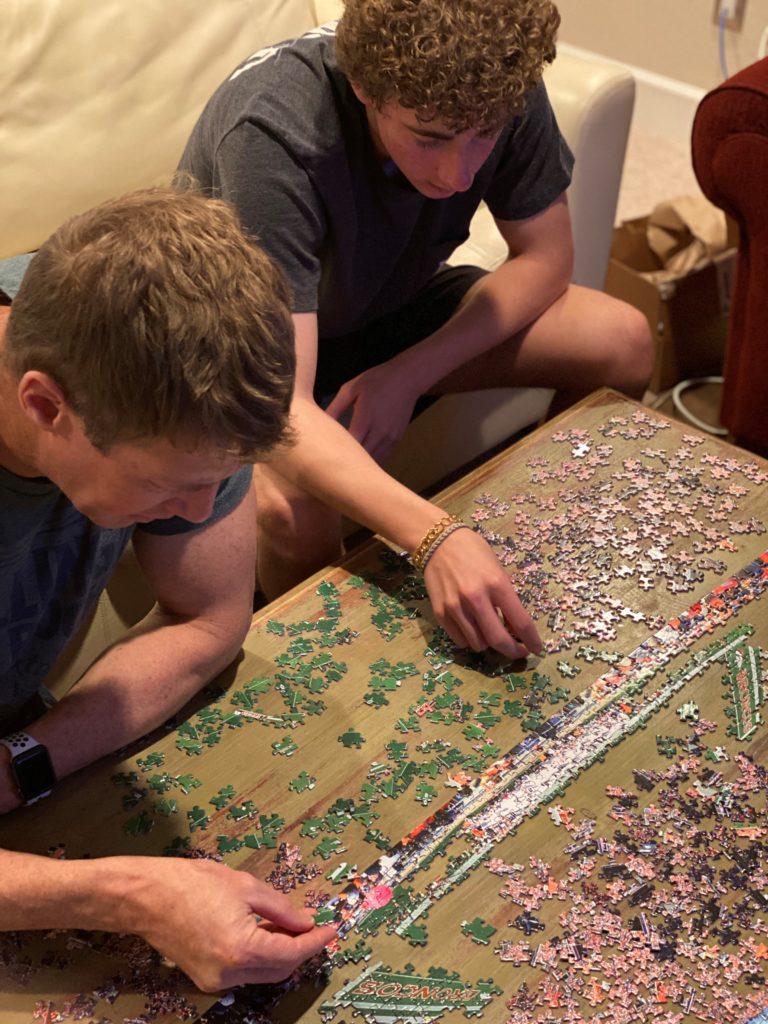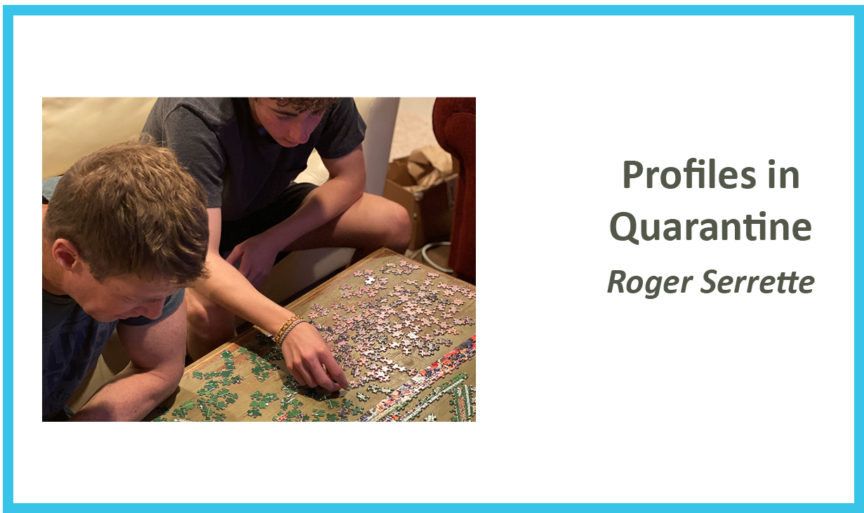We have started hearing from inkjet industry suppliers who are doing their best to serve customers from quarantine like the rest of us. Today we’re talking to Roger Serrette the Customer Experience Center Director for Ricoh USA and one of the most cheerful, friendly people I’ve met in the industry. Since he can’t spend time surrounded by people at the CEC, he has been bringing people (and puzzles) together in quarantine.

Roger, what can you tell us about this picture?
My youngest son (a senior in high school) bought a few puzzles at the start of the stay-at-home order. I’ve never seen him work on a puzzle before, and I’m not a big puzzle fan, but he’s currently chipping away at a massive, 1,000-piece aerial view of a fan-filled Mile High Stadium in Denver, where the Broncos play. There are 80,000 pin-sized fans in the picture, which makes the puzzle difficult – and also makes me wonder when we’ll all get to go to another game together. Every day, I help him with the puzzle for an hour, and if I’m lucky, I get four pieces in. We’ve been working on this puzzle for a few weeks now, and we’ve maybe completed 200 pieces. It’s nice spend the time with him, make meager progress, and be OK with it. The pressure to be productive, every minute of every day, is a little lessened now.
Where is home?
I live in Boulder, Colorado, which is nestled against the foothills just to the east of the Rocky Mountains. As of this writing, it’s snowing: I have 14 inches in my yard, and it’s going to snow all day.
How much do you work from home when there’s not a pandemic?
In my current job I’m typically in the office every day, meeting with customers and conducting multiple briefings per day. Working from home is a huge change of pace for me.
Days at home since March 1?
I came home on the 12th, so 1 month, 6 days, 16 hours and 12 minutes (not that I’m counting).
What are you doing to keep spirits up?
It may be a simple thing, but in the past, I ran conference calls with a mind toward disseminating information quickly and wrapping things up. At the end of calls, I’d say, “OK, here are the four key takeaways from this call based on what I heard. Does anybody have anything to add?” But now the culture has shifted toward checking in on one another and connecting, which is fantastic. On top of that, since it’s harder to gauge when people want to speak up on calls versus during in-person meetings, I try to ask more questions to make sure people have an opportunity to speak up, engage, and share their perspectives. I think this goes a long way in making people feel heard, valued, and supported during this time.
I’ve also been scheduling calls with my team without an agenda. My goal is to give everyone an opportunity to check in and stay connected with the rest of the team. We’re not going to see each other face-to-face for a whil, so it’s nice to have this time to catch up with everyone.
What are your favorite stories of people/companies helping others during the pandemic?
There are countless inspirational examples, large and small. From neighbors donating supplies to others in need to General Motors converting production lines to make face masks, to the married couple – a doctor and an engineer – who designed a way to sterilize used N95s for safe reuse. There are also the many essential workers who, under normal circumstances, are overlooked. These days, I am filled with unending gratitude for our grocery cashiers, health workers, truck and delivery drivers, and healthcare workers. I can’t imagine where we’d be without the sacrifices they’re making and it has put a new perspective on how interconnected we all are.
In my neighborhood, a neighbor organized a group that enables us to check in on one another and to donate or receive everything from groceries to medical supplies to toilet paper. The response has been humbling. People are eager to contribute their time and talents to help out, and it’s very uplifting to see.
What are your top tips for printing companies in managing through the pandemic?
The print industry has been under economic pressures for a long time. I think it was in the 1980s – 40 years ago — when a character in Ghostbusters declared “print is dead.” I know right now it’s hard to get a clear picture of the future, and that can be difficult for a business. But I think it helps to look at what you can control. There are hundreds of times in the past year that printers have told me, “We’ll try to fix that but…” or “We’d retrofit that old press and get it up and running but….” The stumbling block always is “…if we only had the time.” If volumes in your segment are slowing, this is a great opportunity to take on those projects, so you can come back stronger than ever when things begin to open back up – and I believe that they will as print is a motivator, a connector, and valuable tool that reaches across all demographics.
If you’re not sure which projects to focus on, consider working with your team to envision and document current processes or ways to serve customers. You may discover unexpected areas for improvement or gaps between what people think their responsibilities are and what their teammates actually expect. This can uncover hidden trouble spots that, if left unchecked, introduce opportunity for error and inefficiency. Now is a great time to get everyone on the same page.
What do you think OEMs can/should do to help their customers?
How we do business will undoubtedly change, but with a little creativity we can still provide a tremendous value-add relative to education and insights. Reach out to customers to let them know you’re thinking of them and are prepared to help them. Consider shooting an informative or educational video for customers on your iPhone, send it out, and ask them if it’s helpful or what other topics they’d like to hear about from you. While a slick, professional-looking video can be nice, that’s not always possible under these circumstances, and customers will likely appreciate the authenticity.
Now is also a good time for businesses to strengthen their ties to their various communities, including the local communities in which they operate. Let them know you’re in this with them, that you care, that you want to help – and that you’re ready to serve them when they need you, now or in the future. At Ricoh, we’ve been using forums and putting content on our customer portal, Ricoh Business Booster, including information on disinfecting presses to promote safety when production begins to ramp back up. We want to share – and help customers share – best practices and resources to help one another.
Thanks for sharing, Roger.
There are a lot of things printers need to know to run operations safely if they deemed essential services and to shut down and restart safely if they must. Inkjet doesn’t like to be shut down, so make sure to talk to your OEM.
For more information from our OEM partners in quarantine, see also
Global Strategy from my Living Room – Kevin Shimamoto – Memjet

